The year 1969 was pivotal in so many ways for humanity. At its dawn, American astronauts had newly returned from circling the Moon, and by July it had produced our first piloted landfall on another world. These astonishing achievements continue to resonate today—particularly following 2012’s untimely loss of Neil Armstrong—but there is one mission, flown 45 years ago this week, in March 1969, which is a decidedly unsung hero of the effort to plant bootprints on the lunar surface. It rose no higher than a couple of hundred miles from Earth, it went nowhere near the Moon … and yet, without it, those historic steps at the Sea of Tranquility could not have been taken. The mission was Apollo 9, and for its astronauts it would be forever remembered as a mission of gumdrops and spiders, sickness and golden slippers … and the flight of “The Red Rover.”
By the beginning of 1969 the Apollo command and service modules (CSM) which would transport men to the Moon had been extensively tested, but an “all-up” demonstration of the entire ship, including the lunar module (LM), remained untried. The first flight-ready LM had arrived at Cape Kennedy in June 1967, and, though not wholly complete, it was successfully launched on an unmanned test in January of the following year. Its TRW-built descent engine was fired, as was its ascent engine, and the spider-shaped vehicle proved its guidance system. However, all was far from well with the LM. The ascent engine—needed for astronauts to rise from the lunar surface—had fuel-injector problems and the craft’s windows became fractured or blown out during high-temperature tests. Broken wiring, stress corrosion, and excessive weight added to the LM’s headaches.
Still, confidence in the first unmanned mission (LM-1) convinced NASA managers that a repeat (LM-2) was not necessary and efforts accelerated to send LM-3 into orbit with a human crew. It was called “the D-Mission,” and to understand where it “fitted” in the Apollo lunar landing framework, it is important to recap a number of fundamental changes to NASA’s plan.
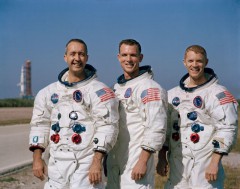
In September 1967, the agency defined seven steps—”A” through “G”—to land on the Moon. First came unmanned tests of the mammoth Saturn V booster with the Apollo CSM, flown as Apollo 4 in November 1967. The “B” mission, completed by Apollo 5 in January 1968, was the unmanned LM test. A piloted “C” flight involved the CSM in Earth orbit and took place in October 1968. The final steps to the Moon focused on four increasingly difficult missions: “D” (a manned demo of the whole Apollo spacecraft in Earth orbit), “E” (a repeat of D, albeit in a high elliptical orbit), “F” (a full dress rehearsal in lunar orbit), and “G” (the landing itself).
During the course of 1966, astronauts Jim McDivitt, Dave Scott, and Rusty Schweickart were named to support the D mission. Their CSM would be launched atop a Saturn IB rocket, followed a few days later by the launch of another Saturn IB, carrying LM-3. McDivitt’s crew would rendezvous, dock, and perform joint exercises with the lunar module, including a spacewalk by Schweickart to put the lunar EVA suit through its paces. Chomping hard at the heels of McDivitt’s team was the E crew of Frank Borman, Mike Collins, and Bill Anders … but circumstances in early 1967 would complicate the relationship between these six men.
On 27 January, astronauts Virgil “Gus” Grissom, Ed White, and Roger Chaffee were killed when a flash fire swept through their command module during a launch pad test. More than a year later, the McDivitt and Borman crews seemed in line to fly the D and E missions sometime in late 1968 or early 1969. However, when the Saturn V flew its enormously successful first flight, and worried by CIA reports that the Soviet Union was close to testing its own lunar rocket, NASA accelerated Borman’s mission to a full-blown circumlunar expedition, thus eliminating one of the steps in the A-G plan and bringing the landing closer. Hopes that their E mission could be retasked as something called “E-prime,” flying to the Moon with LM-3, fell to pieces when it became obvious that the lunar module would not be ready in time. In August 1968, it was decided that Borman’s crew would fly first on Apollo 8 to circumnavigate the Moon, without an LM, after which McDivitt’s men would fly Apollo 9 on the D mission to wring out the whole spacecraft in Earth orbit.
Apollo 9 would be a tough mission, involving two separate manned spacecraft … and for Dave Scott, the command module pilot, it encapsulated rendezvous, docking, and an unspoken need to train for worst-case, what-if scenarios. If McDivitt and Schweickart, after undocking, were somehow unable to control the LM, Scott might be able to dock with them manually … but if not, the harrowing alternative was that he might have to abandon them and return home alone. “Bringing Apollo home as a one-man show,” Scott wrote in his memoir, Two Sides of the Moon, “involved my mastering many aspects of all three jobs performed by the crew, Jim’s as commander, Rusty’s as systems engineer, my own as navigator. The sheer logistics of operating in all three positions, let alone learning the complex procedures this would require, was challenging, to say the least.”
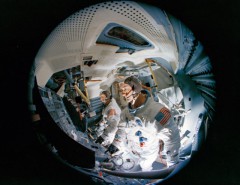
During training, Scott had devised a routine in the simulator to handle this daunting role. First, he would check Apollo’s electrical, communications, and environmental systems from Schweickart’s seat, then would move to the center couch to fulfil his own duties of setting up the relevant programs on the computer, before finally moving into McDivitt’s couch to perform the re-entry manoeuvre itself. “It was pretty exacting,” he wrote. Yet it was a dire eventuality for which all Apollo command module pilots would have to be prepared.
Equally exacting was the possibility that Scott might have to rescue McDivitt and Schweickart if the LM developed problems. For example, if it was unable to initiate its correct rendezvous maneuver within a minute of when it was planned, he would need to rescue them. If the two craft successfully redocked, but the pressurized tunnel was inaccessible, or if the hatches failed to open, McDivitt and Schweickart would need to leave the lunar module in their suits and spacewalk back over to the command module’s side hatch. And this was hampered by the fact that McDivitt (who was not scheduled to make an EVA) would have been totally reliant upon Schweickart’s emergency oxygen supply. “If he didn’t make the EVA transfer within 45 minutes,” Scott wrote, darkly, “he would die.”
For months, the astronauts and their backups, Pete Conrad, Dick Gordon, and Al Bean, methodically rehearsed the complicated steps; steps which were further compounded as technicians and engineers tested them by dreaming up failures, systems faults, and other emergencies. “Our launch was almost postponed,” added Scott, “because we could not get enough training, especially for the rendezvous profile. After every sim was finished, we were debriefed and often had to explain why we had failed to deal with a particular situation. It was all pretty intense.”
Apollo 9 was indeed postponed, but not through lack of training. Originally set to fly on the last day of February 1969, the crew arrived at Cape Kennedy three weeks prior to launch to finish their training and quarantine. Living conditions had changed quite markedly from the spartan crew quarters of Mercury and Gemini days: they each had individual bedrooms, a shared bathroom, a large and comfortable living area, a miniature gym in which they played handball at night, and a superb chef, Lew Hartzell. “He was great,” Scott related, “a former cook on a tugboat, who served us with marvelous meals every time we sat down.” But in the final days before launch, Jim McDivitt’s white blood-cell count was found to be low, hinting that he might be coming down with a cold.
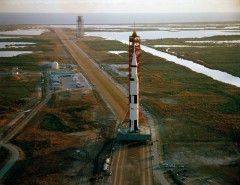
By this time, the giant Saturn V booster had been sitting on swamp-fringed Pad 39A for almost two months, and its 28-hour launch countdown had begun. Thirty minutes into a planned three-hour hold at T-16 hours, managers decided to recycle the clock to T-42 hours and give McDivitt time to recover his strength. Indeed, in his autobiography, Deke Slayton related that “all three of the crew came down with colds,” a suggestion which Scott and Schweickart attempted to dismiss by donning jogging clothes and running around the perimeter of the launch complex. Flight International quoted a medical report from the astronauts’ physician, Dr. Chuck Berry, which mentioned “sore throats and nose congestion.” Whatever the truth, it certainly illustrated, in Slayton’s mind, that the crews were being worked hard and were increasingly susceptible to “opportunistic infections.”
The brief postponement did not detract from what promised to be a spectacular, though challenging, year for NASA: the year in which John Kennedy’s very public promise to land a man on the Moon would be realised. Up to five missions were planned, each one building on—and dependent on—the success of its predecessor. If the D mission was a success, the stage would be set for Tom Stafford, John Young, and Gene Cernan to ride Apollo 10 to the Moon in May for the F mission. Only if Stafford’s flight verified the performance of the LM’s engines and consolidated knowledge of the lunar gravitational field, could Apollo 11—the long-awaited G mission, with Neil Armstrong in command—stand any chance of touching down on the lunar soil sometime in July. Despite the confidence, the doubts remained. If Apollo 11 did not succeed, the task of making the first landing would pass to Apollo 12 in September, and if that failed there would be time for Apollo 13 in November to achieve Kennedy’s deadline.
Even with the benefit of hindsight, it remains remarkable that such enormous steps were taken in such a short span of time. Four percent of the federal budget (during the mid-1960s) had much to do with the hectic pace of Apollo’s journey to the Moon, but the ability of the United States to achieve a lunar landing on this timescale—barely eight years—certainly puts current projects to return humans to the lunar surface to shame. In an ironic twist, closer and more cordial working ties with the Soviet Union, cemented by the Strategic Arms Limitation Talks from 1969 onward, eliminated the need for such a vigorous, all-or-nothing human space program. Apollo’s race to the Moon was seen, quite literally, as “peaceful warfare” with the Soviets and the astronauts were its warriors. “We were at war,” wrote Gene Cernan in his autobiography, The Last Man on the Moon. “If they reached the Moon first, it would be Sputnik and Gagarin all over again, but much worse, and we would be the losers.” Unlike Sputnik and Gagarin, failure to achieve the lunar landing would not simply be embarrassing, it would represent an abject failure to deliver on Kennedy’s promise. As February wore into March 1969, the Apollo 9 crew—colds or no colds—could not launch soon enough.
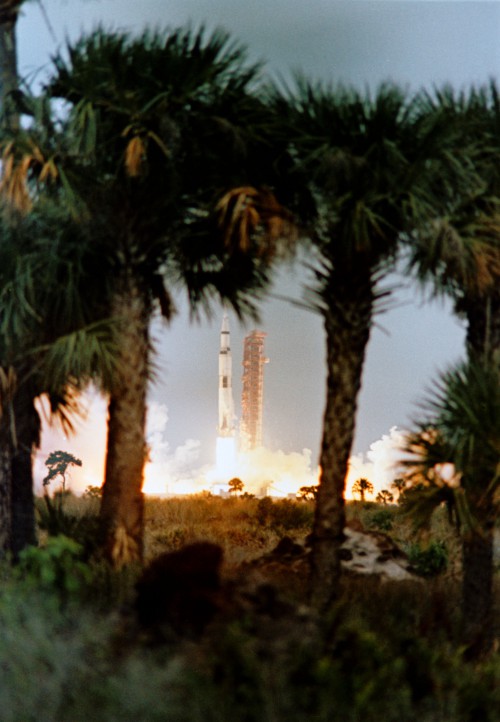
By 7:30 a.m. EST, 1 March, when the clock resumed, the main concerns surrounded a low-pressure disturbance in the Gulf of Mexico, just southwest of Cape Kennedy, which was causing overcast weather conditions. As the countdown entered its final stretch, dull, storm-bringing stratocumulus clouds covered 70 percent of the sky, with darker blotches of altostratus high above them. Nonetheless, preparations continued. On the evening of 2 March, Scott and Schweickart drove out to the pad to watch as their Saturn V, lit up by searchlights, underwent its final checks. Next morning, clad in their pure white space suits, the three astronauts arrived at the pad to a very different scene. The scores of engineers and technicians were gone and it was an eerily silent place, the sense of stillness punctuated only by the hissing of the Saturn itself. As technicians helped Jim McDivitt into the left-hand seat of the command module and Rusty Schweickart into the seat on the right, Scott waited patiently outside on the gantry and had a few precious minutes to gaze out across the marshy expanse of the Cape and watch the Sun peek over the horizon.
Precisely on the stroke of 11:00 a.m., the five mighty F-1 engines in the Saturn V’s first stage roared to life. From a height, weight, and payload-to-orbit standpoint, it remains the largest and most powerful rocket ever brought to operational status. McDivitt, Scott, and Schweickart’s ride to orbit was virtually trouble-free, although the experience was truly unforgettable. For Scott, who flew two Saturn Vs in his astronaut career, it was like being compressed and released atop a giant spring, as the forces and vibrations alternately threw them against their restraining straps, then smashed them back into their seats.
In space, Scott’s first task would make or break Apollo 9. Less than three hours after launch, he separated the CSM from the S-IVB final stage of the Saturn, whose adaptor panels were automatically jettisoned to expose LM-3. Using the thruster quads on the service module, Scott crisply turned his ship 180 degrees and prepared to dock with the spidery lander. At this point, the first problem arose when Scott found that his translational thrusters were not functioning properly. “If we couldn’t pull the lunar module out from its storage pod,” he wrote, “we didn’t have a mission. We had this short moment when it seemed it wasn’t going to work.” As he held the ship’s position steady, McDivitt and Schweickart scrambled to identify the cause of the problem. Eventually, it was traced to several of the attitude engine indicators, whose propellant valves were showing up as “closed.”
“After all the pre-flight testing of the valves,” Scott continued, “this was certainly not supposed to happen. At one point ground control thought one of us must have bumped several of the switches closed as we were jostled around during launch, but we were strapped into our seats so tightly this was impossible. Later analysis concluded that the valves had flicked shut as a result of the shock caused by staging.” The problem was fairly straightforward to rectify: McDivitt recycled the switches to “open,” and Scott was able to execute a perfect nose-to-nose docking, a little over three hours into the mission. The intricate procedure, known as “transposition and docking,” was critical: On missions to the Moon, it would be done after the S-IVB had performed the translunar injection burn, “and that,” wrote astronaut Mike Collins in his memoir, Carrying the Fire, “was no time to discover that the scheme didn’t work for some reason.”
In its Apollo 9 press kit, NASA identified no fewer than seven “alternate” flight plans which McDivitt, Scott, and Schweickart might pursue in the event of problems. Firstly, Alternate “A” presupposed a problem with the extraction of LM-3 from the S-IVB … and this would have enforced a full-duration, 10-day solo mission with just the CSM. The other alternates applied to problems with LM-3 itself—covering everything from life-support system failures to a troublesome engine, and from a faulty rendezvous radar to an unsafe descent stage—and in each case the crew would have performed as much as they could with the available set of options. Whatever happened, if possible they would attempt station-keeping with the lander, Schweickart’s EVA, and a long burn of the descent and ascent engines.

In completing the first transposition and docking, the Apollo 9 crew had achieved the first American link-up between two pressurized, habitable spacecraft. The next order of business was to confirm that the docking probe and tunnel between the command and service modules and the lunar module was functional. Unlike the spacewalk by Soviet cosmonauts Yevgeni Khrunov and Alexei Yeliseyev in January 1969, McDivitt and Schweickart would transfer between ships internally, in shirtsleeves.
After pressurizing the 4-foot-long tunnel between the two craft, verifying the integrity of the 12 latches on the docking ring, connecting umbilicals to provide the lunar module with electrical power, and disassembling the probe and drogue, it was time to separate from the S-IVB for good. Four hours into the mission, Scott threw a switch which fired pyrotechnics to release the lunar module from the S-IVB, and again pulsed the thruster quads to draw the complete Apollo craft free. Forty minutes after separation, the S-IVB’s restartable J-2 engine was lit again to enter an “intermediate coasting” orbit, preparatory for a third and final burn. The final firing, which began some six hours into the mission and burned until the propellant supply was all used up, allowed the S-IVB to escape Earth’s gravitational influence and established it in a solar orbit. Major objectives of the repeat firings were to demonstrate the J-2’s ability to restart and to test its performance under conditions beyond those for which it was designed.
In the meantime, McDivitt, Scott, and Schweickart were preoccupied for the remainder of their first day in orbit with checks to ensure that the combined command, service, and lunar modules were spaceworthy. Among their initial tasks was a series of firings of the Service Propulsion System (SPS) engine, one of whose primary roles on missions to the Moon would be to perform the lunar-orbit-insertion and transearth injection burns. The first SPS burn, conducted late on 3 March and lasting five seconds, verified that the combined spacecraft could withstand the stress and gauge their “oscillatory response.”
With this work complete, the time finally came for what Slayton called the mission’s “big deal”—the checkout of LM-3 by McDivitt and Schweickart. After Schweickart made a dramatic spacewalk, the lunar module was to undock for a series of joint rendezvous exercises. During his planned two-hour excursion, Schweickart was to put the EVA suit with its bulky backpack, designed to enable astronauts to work on the lunar surface, through its paces. He was to exit through the small, square hatch and onto the lunar module’s front “porch.” Scott had spent more than two years perfecting his knowledge of the CSM, so McDivitt and Schweickart had devoted themselves to understanding every inch of “their” ship. Each man had prepared exhaustively for his respective tasks.
What they had not prepared for, or bargained on, was Schweickart’s adverse reaction to the space environment, which almost stalled the mission in its tracks.
The second part of this article will appear tomorrow.
Want to keep up-to-date with all things space? Be sure to “Like” AmericaSpace on Facebook and follow us on Twitter: @AmericaSpace
Missions » Apollo »



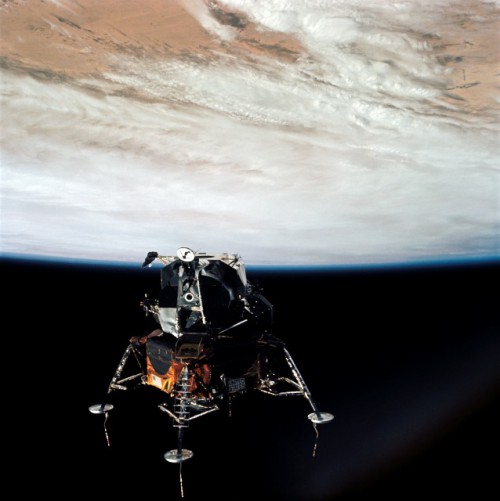
Unfortunately, history views this mission as a minor blip on the screen that was the Apollo Program. A total injustice to the men and women that made it such a raging success. Without 9 there couldn’t be a 10. Without 10, no 11 etc.
Ben Evans has written another jewel filled with exquisite details, some of which, I was unaware until now. The posts listed at the end are a valuable resource to the reader. I look forward to Part 2 tomorrow. Great job, Ben!
The development of the LM and the flight of Apollo 9 were covered in my favorite episode, “Spider”, in “From the Earth to the Moon”.